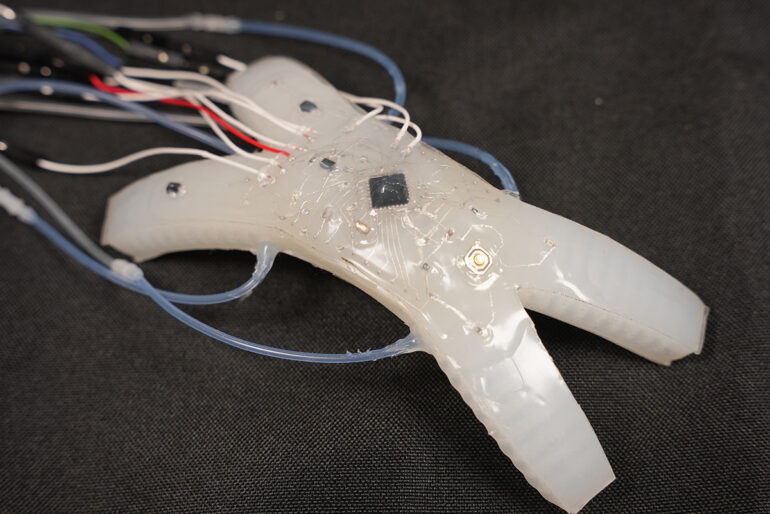From search-and-rescue missions to orthopedic therapy and many other applications, soft robots and wearable electronic devices show great promise for many fields. However, designing them to be functional and practical to use has proved challenging.
In the lab of Prof. Rebecca Kramer-Bottiglio, a team of researchers has developed complex electronics that can stretch substantially beyond their original shape. Further, the system can be easily adapted to different uses. The results of their work are published in Science Robotics.
The field of stretchable robots is often stymied by the interfacing between the devices’ rigid and soft components. That is, they require complex circuitry that currently is too rigid to be tightly integrated into their soft bodies. As a result, designers pair their devices with external circuit boards, which sacrifices the devices’ functionality.
To that end, the researchers in Kramer-Bottiglio’s lab developed stretchable versions of an Arduino—a widely used open-sourced electronics platform—and embedded them into soft robots. Not only do these devices stretch substantially and still work as designed, but they were created to be scalable and easily reproduced.
It is the most complex circuit that’s been demonstrated to be able to stretch substantially—a vital step toward developing soft robots and wearable devices that don’t sacrifice computing power for stretchability.
Most soft robots today are controlled by rigid Arduino-style microcontrollers. To accommodate the mismatch between the robots’ soft materials and the rigid circuitry, designers will often try to place the electronics where it will create the least amount of interference in stretching.
In Kramer-Bottiglio’s lab, though, the researchers placed the circuitry at specifically high-strain locations to illustrate their robustness. This provides greater freedom for other roboticists in how they design their devices. In the researchers’ devices, there were more than 70 points of contact between rigid and soft components that all stretched in application and testing.
“We were able to overcome the usual obstacles with our manufacturing process and actually create many stretchable Arduinos,” said Stephanie Woodman, lead author of the study and a Ph.D. student in Kramer-Bottiglio’s lab.
They turned out to be very stretchable, elongating three to four times from their original shapes.
“The demonstrations collectively mark a transition from one-off, functionally limited showcases to robust, reliable, and complex multilayer stretchable circuits,” said Kramer-Bottiglio, the John J. Lee Associate Professor of Mechanical Engineering & Materials Science.
For this project, the researchers focused on making the system accessible and applicable to different uses. To demonstrate the method’s generality, they applied it to make stretchable versions of the popular Arduino Pro Mini, as well as the Arduino Lilypad, the Sparkfun Sound Detector, the Sparkfun RGB and the Gesture Sensor. And in developing the method, they also eliminated any need for extensive equipment or materials, expertise, or circuit design expertise.
The researchers began with a gallium-based liquid metal. To make the material paintable and easy to use, they stirred the liquid metal to expose it to oxygen.
“That lets it go into this paste form, which is much more patternable, and allows it to strongly adhere to all these soft substrates and rigid electrical components,” Woodman said.
They then painted this material over masks made from paper that had been laser cut into the desired circuit pattern, so that when the mask was removed, circuit components could be placed and the layer could be encapsulated. All of their fabrication materials, methods, and circuit designs are open-sourced—their process for making stretchable electronics is demonstrated in this GitHub page.
Now that they’ve developed these stretchable circuits, the roboticists have plenty of ways to use them.
“We embedded it into several soft robots,” Woodman said. “For instance, one controls the gate of a quadruped robot while stretching.” She added that the stretchable electronics don’t interfere with how the robots morph.
Wearable devices—those that assist with injured limbs, for example—are another application.
“We put our circuit right on the elbow and showed it stretching,” Woodman said, adding that the elbow is one of the trickiest places to apply a wearable device, due to the amount of stretching involved.
“So not only are we making really stretchable circuits, but we’re actually showing how this can be practically deployed in use cases all over the body and in the soft robots of tomorrow.”
More information:
Stephanie J. Woodman et al, Stretchable Arduinos embedded in soft robots, Science Robotics (2024). DOI: 10.1126/scirobotics.adn6844
Citation:
Stretching the possibilities of soft robots with flexible electronics (2024, September 12)



